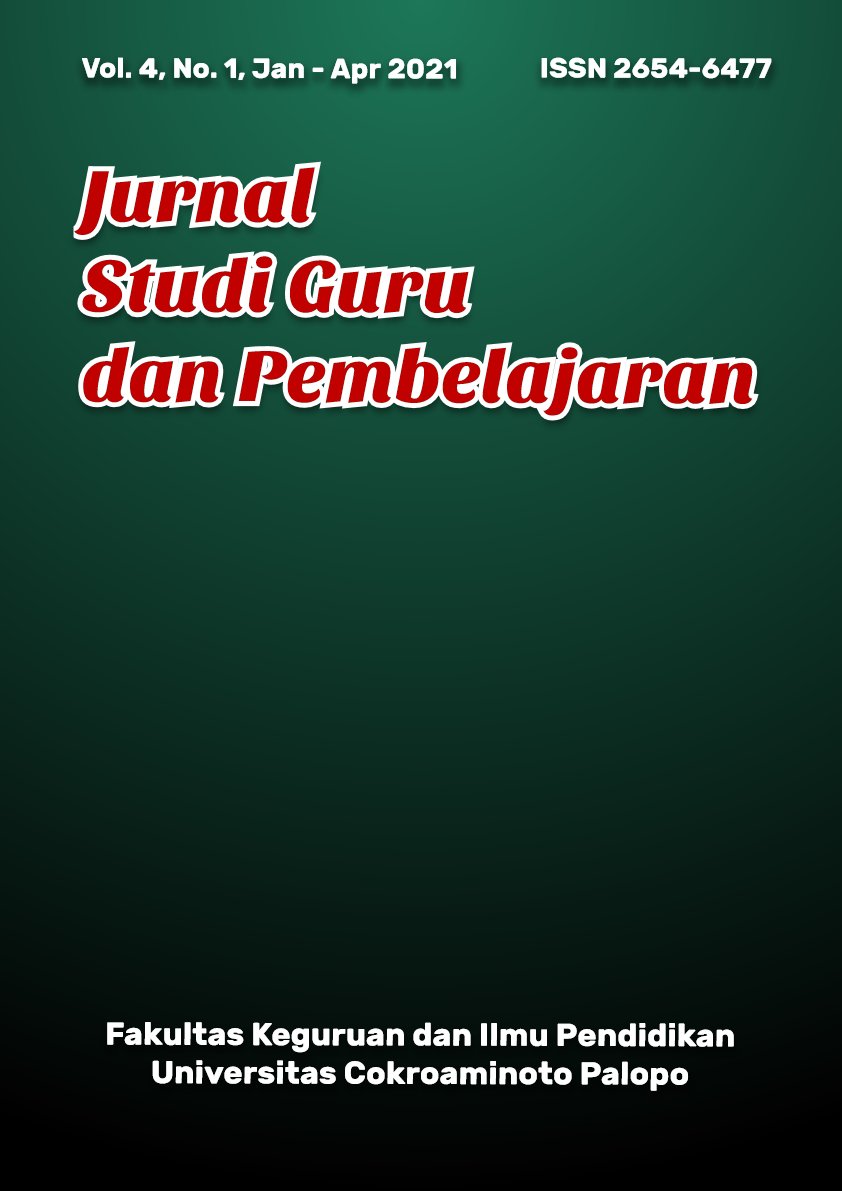Penerapan Media Pembelajaran Video Dokumenter Materi Hutan Mangrove pada Mahasiswa Program Studi Kimia UNCP
DOI:
https://doi.org/10.30605/jsgp.4.1.2021.532Keywords:
Learning Media, Video documentary, Mangrove ForestAbstract
The research objective to apply documentary video media in learning of increase knowledge chemistry study program students. Documentary video containing mangrove forest material to delivered using the zoom application in October 2020 as many as 14 people as a sample for direct appointment. The step research to used action method to making documentary video tools that were validated by instructional media experts to be fit for use, and evaluation questions using to google form software in online students after the learning process. The ability of students the understand material the 10 people dominant in medium category from of total sample 14 people with of percentage 72 percent. The high category learning outcomes were 3 people with of percentage 21 percent. The low category understands the material as much as 1 person with of percentage 7 percent. Learning outcomes to interpreted the ability to understand mangrove forest material uses documentary video media not good because the dominant category in medium. The Upgrade student knowledge of mangrove forest material using documentary video media gives medium category effects, and some are high categories
Downloads
References
Asri, A., Junaid, R., & Saputra, S. (2020). The Development of Learning Model through Video Documentary to Improve Environmental Knowledge of Coastal Residents of Palopo City, Indonesia. Jurnal Pendidikan IPA Indonesia, 9(3), 396-407. DOI: https://doi.org/10.15294/jpii.v9i3.23358
Baharuddin, M. R., & Jumarniati, J. (2018). Pola Interaksi Belajar Matematika Siswa Berkemampuan Awal Rendah dalam Pembelajaran Berbasis Proyek. Al-Khwarizmi: Jurnal Pendidikan Matematika dan Ilmu Pengetahuan Alam, 6(2), 149-156. DOI: https://doi.org/10.24256/jpmipa.v6i2.316
Baharun, H. (2016). Pengembangan media pembelajaran PAI berbasis lingkungan melalui model assure. Cendekia: Jurnal Kependidikan Dan Kemasyarakatan, 14(2), 231-246. DOI: https://doi.org/10.21154/cendekia.v14i2.610
Iskandar, Z. (2016). Environmental psychology. Bandung. PT Refika Aditama
Junaid, R., & Baharuddin, M. R. (2020). Pemenuhan Hak Belajar Siswa melalui PKM Lesson Study. JCES (Journal of Character Education Society), 3(3), 522-534. DOI: https://doi.org/10.35914/tomaega.v3i2.413
Manik. K. E. S. (2018). Management of the environment. Jakarta. Prenadamedia Goup Indonesia.
Muslim, B., Zulfiani, Z., & Irwandi, D. (2014). Pembelajaran kimia melalui metode eksperimen berbasis lingkungan alam sekitar ditinjau dalam perspektif islam. TARBIYA: Journal of Education in Muslim Society, 1(2), 189-202. DOI: https://doi.org/10.15408/tjems.v1i2.1267
Said, N. I. (2017). Wastewater Management of Technology. Jakarta. PT. Gelora Aksara Pratama Indonesia.
Salam, M., Ibrahim, N., & Sukardjo, M. (2019). Effects of Instructional Models and Spatial Intelligence on the Mathematics Learning Outcomes after Controlling for Students' Initial Competency. International Journal of Instruction, 12(3), 699-716. DOI: https://doi.org/10.29333/iji.2019.12342a
Sembel D. T., (2015). Environmental Toxicology (Impact of pollution from various chemicals in daily life), Yogyakarta: CV. Andi offset.
Smaldino, S. E., Lowther, D. L., Russell, J. D., & Mims, C. (2008). Instructional technology and media for learning. Terjemahkan oleh: Arif Rahman. Jakarta: Pranada Media Group Indonesia.
Spillman, D. (2017). Coming home to place: Aboriginal Lore and place-responsive pedagogy for transformative learning in Australian outdoor education. Journal of Outdoor and Environmental Education, 20(1), 14-24. DOI: https://doi.org/10.1007/BF03400999
Sukardi. (2016). Educational Research Methodology. PT. Bumi Aksara.
Syukri, H. (2013). Pendidikan Lingkungan. Bandung: Pt refika aditama.
Wena, M. (2011). Strategi Pembelajaran Inovatif Kontenporer. Jakarta:PT Bumi Aksara.
Winkel, (2019). teaching psychology. Jogyakarta. Media Abadi Indonesia.
Wuryastuti, S., & Ni'mah, I. (2013). Model Pembelajaran Berbasis Lingkungan Untuk Meningkatkan Kecakapan Hidup Mahasiswa Melalui Pembuatan Kompor Biogas. EduHumaniora| Jurnal Pendidikan Dasar Kampus Cibiru, 5(2). DOI: https://doi.org/10.17509/eh.v5i2.2842
Yulianti, N. (2016). Pengaruh model inkuiri terbimbing berbasis lingkungan terhadap kemampuan pemahaman konsep dan karakter. Jurnal Cakrawala Pendas, 2(2). DOI: https://doi.org/10.31949/jcp.v2i2.329
Downloads
Published
How to Cite
Issue
Section
License
In submitting the manuscript to the journal, the authors certify that:
- They are authorized by their co-authors to enter into these arrangements.
- The work described has not been formally published before, except in the form of an abstract or as part of a published lecture, review, thesis, or overlay journal.
- That it is not under consideration for publication elsewhere,
- That its publication has been approved by all the author(s) and by the responsible authorities – tacitly or explicitly – of the institutes where the work has been carried out.
- They secure the right to reproduce any material that has already been published or copyrighted elsewhere.
- They agree to the following license and copyright agreement.
License and Copyright Agreement
Authors who publish with JSGP agree to the following terms:
- Authors retain copyright and grant the journal right of first publication with the work simultaneously licensed under Creative Commons Attribution License (CC BY-SA 4.0) that allows others to share the work with an acknowledgement of the work's authorship and initial publication in this journal.
- Authors are able to enter into separate, additional contractual arrangements for the non-exclusive distribution of the journal's published version of the work (e.g., post it to an institutional repository or publish it in a book), with an acknowledgement of its initial publication in this journal.
- Authors are permitted and encouraged to post their work online (e.g., in institutional repositories or on their website) prior to and during the submission process, as it can lead to productive exchanges, as well as earlier and greater citation of published work.






